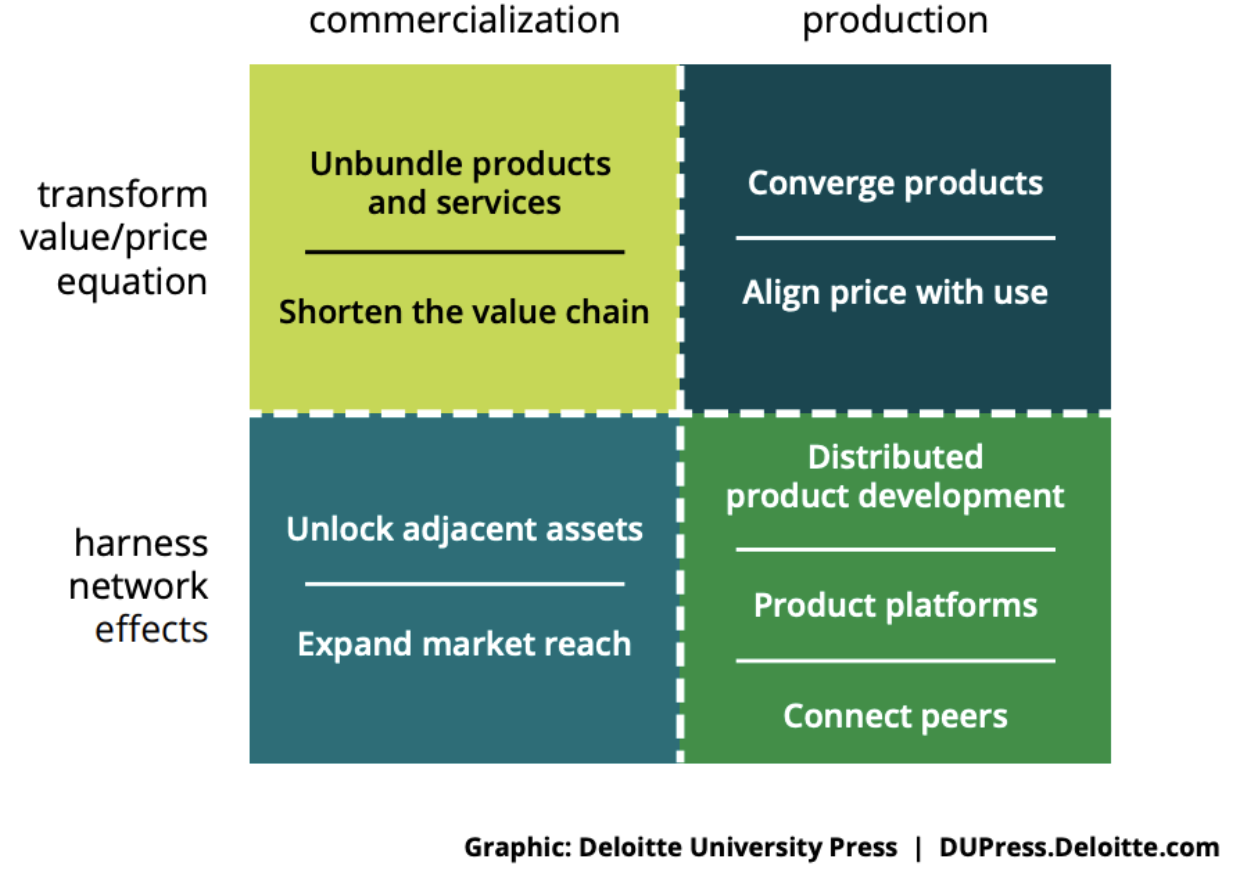The Synergy Between Disruptive Innovation and Network Effects
Disruptive innovation and network effects have become two critical forces driving the transformation of industries and reshaping the competitive landscape in the digital era. The convergence of these phenomena has given rise to a new paradigm, where economic value is increasingly concentrated among a small number of dominant players. As traditional market dynamics give way to the power of scale and network effects, companies must adapt their strategies to thrive in this rapidly evolving environment.
Tip: Analyze current market trends and identify where network effects are already impacting your industry. Invest in research to understand the disruptive forces that could affect your business model.
The focus of research and theory on creating value through a platform strategy (more on that below) largely centers around the establishment of network effects and expansion cycles involving both supply and demand actors. EY’s investigations into this area reveal how ecosystems can contribute to enhancing stakeholder value while fostering innovation and operational efficiencies:
The Power Curve of Disruption
The power curve of disruption, characterized by steep disparities between big winners and losers, is a manifestation of the influence of network effects. McKinsey’s research reveals that the power curve has become steeper over the past decade, with a few dominant companies capturing a disproportionate share of economic profits. These winners often come from the high-tech and media sectors, where they leverage scale and network advantages to create reinforcing feedback loops.
Tip: Be aware of the widening gap between industry winners and losers and position your company to leverage scale and network advantages.
Companies that extract huge volumes of customer data from their scale and network advantages start a virtuous cycle, enabling them to locate potential threats early on and form valuable partnerships to protect their value chains in the face of mounting digital pressure. Consequently, incumbents that focus on maintaining a market share relative to peers without adapting to the changing landscape face significant risks. Emphasizing traditional metrics, such as market share and niche profitability, may no longer guarantee success in the digital era.
Tip: Invest in systems that can collect and analyze large volumes of customer data to create personalized experiences. Implement feedback loops to continually enhance customer engagement.
Network Effects: Creating Reinforcing Feedback Loops
Network effects are at the core of the power curve phenomenon. One of the most potent forms of network effects arises from data accumulation and utilization. The more data a company collects, the more it can personalize the customer experience. Increased personalization, in turn, attracts more customers, leading to even more data. This reinforcing feedback loop solidifies customer loyalty and strengthens the position of dominant players, allowing them to put up significant entry barriers for potential rivals.
Amazon and Apple serve as prime examples of companies that have harnessed network effects to their advantage. Amazon’s marketplace brings together an extensive network of buyers and sellers, enabling a diverse range of product offerings and driving value for all participants. Meanwhile, Apple’s iPhone ecosystem has cultivated a vast network of app developers, which, in turn, enriches the user experience, further reinforcing customer loyalty.
Get your Disruptive Innovation Demo →
Harnessing Network Effects: Five Patterns of Disruption
In Deloitte’s framework, five patterns of disruption harness the power of network effects to drive increasing returns:

1. Expand Market Reach
Companies can create sustainable advantages by connecting fragmented buyers and sellers, thus expanding their customer bases and amplifying network effects. Platforms like Alibaba and eBay have successfully capitalized on this pattern by creating vast digital marketplaces that connect buyers and sellers globally, enabling participants to choose from a wealth of products and services.
2. Unlock Adjacent Assets
Cultivating opportunities on the edge of existing businesses makes it possible for companies to tap into new markets and sources of value. For example, Google’s expansion into various industries, such as autonomous vehicles through Waymo and life sciences through Verily, demonstrates how leveraging adjacent assets can open new growth avenues.
3. Turn Products into Platforms
Transforming products into platforms that provide a foundation for others to build upon fosters collaboration and encourages network growth. Companies like Microsoft and Apple have successfully employed this strategy by creating ecosystems around their operating systems, enabling developers to create and distribute apps on their platforms.
4. Connect Peers
Facilitating direct, peer-to-peer connections empowers participants to engage more actively within the ecosystem. Social media networks like Facebook, LinkedIn, and X (formerly Twitter) thrive on the strength of their P2P networks, where users connect and interact directly with one another, driving engagement and data generation.
5. Distribute Product Development
Mobilizing multiple stakeholders to contribute to product development enhances innovation and strengthens the network. Linux and Apache—both open-source software projects—showcase the power of distributed development, where a community of contributors collaborates to improve and expand the capabilities of a product.
Tip: Apply the five patterns of disruption (Expand Market Reach, Unlock Adjacent Assets, Turn Products into Platforms, Connect Peers, Distribute Product Development) to your business strategy. Pilot initiatives in line with these patterns.
Shaping the Marketplace through Network Effects
Leading companies have effectively shaped their respective marketplaces through network effects, solidifying their positions as dominant players. Facebook, for example, has reinvented interactions between users, developers, and businesses within its platform. The interconnectedness of these groups, coupled with personalized content, keeps users engaged and incentivized to return repeatedly.
Similarly, Amazon and FedEx have built logistics networks with numerous ecosystem partners, streamlining the delivery process and enabling consumers to get shipments within hours of placing an order. This level of convenience and speed has significantly influenced customer expectations, leading to heightened demand for similar services in other industries.
Tip: Investigate the possibility of developing or participating in platforms that allow for network growth. Consider partnerships, joint ventures, or acquisitions that will contribute to scale and network advantages.
Collaborative Consumption and the Sharing Economy
The sharing economy represents a remarkable example of how network effects can foster innovation and disruption, even under challenging economic circumstances. In the aftermath of the 2007–2008 GFC and the following recession, consumers and businesses sought cost-effective alternatives to meet their needs without incurring significant expenses. The sharing economy, with its emphasis on collaborative consumption and resource sharing, gained popularity, leading to the explosive growth of platforms like Airbnb, Uber, and TaskRabbit.
In this climate of economic uncertainty, consumers were more open to trying new models that delivered value, while businesses found growth opportunities in providing sharing economy services. These platforms flourished by capitalizing on network effects, connecting consumers directly with service providers and creating efficient marketplaces.
Tip: Explore opportunities for engaging in the sharing economy, aligning with consumer trends and needs.
Going Horizontal Across Industries
Network effect patterns also offer companies the ability to “go horizontal” across industries, facilitating the expansion into new markets and industries. Uber’s entrance into grocery delivery and takeout services exemplifies how companies can leverage their existing platforms to diversify and broaden their business scope.
When a company owns a robust platform with significant network effects, it can attract participants from various industries, creating a more comprehensive ecosystem. This strategy can lead to the appearance of dominant players wielding influence across diverse sectors.
Tip: Assess the feasibility of leveraging your existing platform or network to diversify into new markets and industries.
Big Data and AI: A Transformative Blend
Network effects amplify the value of data in the digital age, paving the way for transformative advancements in artificial intelligence (AI). The accumulation of vast amounts of data through network interactions fuels AI algorithms and deep learning, significantly improving their accuracy and capabilities.
Historically, businesses made decisions based on data samples and statistical inferences. However, with the advent of Big Data, computation can be performed on all available information, eliminating sampling errors. This paradigm shift allows AI to perform precise predictive and prescriptive analytics, enabling companies to make data-driven decisions with unparalleled accuracy.
Companies like Google, Amazon, and Netflix leverage AI and Big Data to deliver personalized recommendations, enhancing customer experiences and deepening customer engagement. Additionally, AI’s ability to process large datasets has revolutionized fields like healthcare, finance, and manufacturing, enabling disruptive innovation and the optimization of complex processes.
Tip: Invest in AI and Big Data capabilities to enhance decision-making, customer experience, and process optimization.
Bottom Line
The digital era demands a strategic focus on network effects and disruptive innovation, as companies that understand and adapt to these interconnected forces will thrive while others risk obsolescence.
Tip: Foster a company-wide understanding of the importance of disruptive innovation and network effects. Encourage and reward innovation at all levels.
Explore battle-proven, trusted tools like InnovationCastⓇ and other innovation management platforms to support your efforts in strategizing disruptive innovation and kickstarting the network effect.


